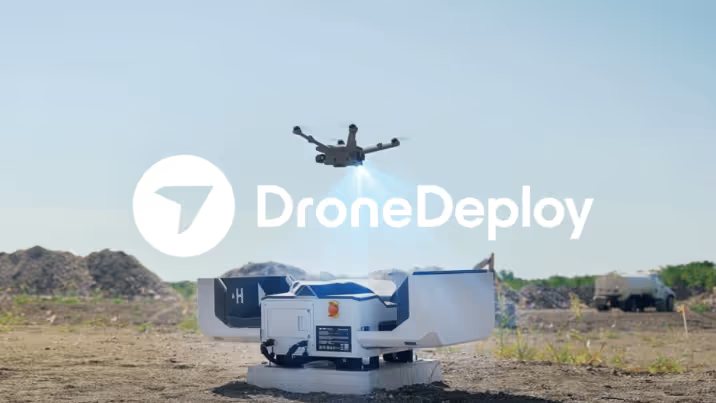Everything you need to know about the DJI Dock 2

Quick Summary
The DJI Dock 2 is a major leap forward in automated drone operations, offering a 75% smaller footprint, faster preflight, and RTK-powered precision for survey-grade mapping. With enhanced durability, 10 km range, longer flight times, and built-in backup power, it enables consistent, remote deployments in tough environments. Integrated with DroneDeploy, Dock 2 automates missions from takeoff to upload, securing data in the cloud while supporting BVLOS readiness. It's compatible with Matrice 3D and 3DT drones and ideal for teams ready to scale site capture without adding complexity.
The DJI Dock 2 has landed, and it's a major leap forward for automated drone solutions. The original Dock brought deeper automation to drone mapping, but the Dock 2 goes further with its smaller form factor, faster operation and expanded capabilities. Paired withDock Automation in DroneDeploy, the Dock 2 redefines efficiency and accuracy across industries and use cases.
This is your comprehensive overview of the DJI Dock 2. In this guide, you’ll learn how the Dock 2 and DroneDeploy can transform your drone operations, saving you time, improving accuracy, enhancing data security and boosting safety.
Here's a quick rundown of what to expect:
- The Dock 2 advantage: features that set it apart
- Dock 2 compatible drones
- Dock 2 FAQ
- DroneDeploy + DJI Dock 2: seamless integration

The Dock 2 advantage: features that set it apart
While the Dock 1 was great, the DJI Dock 2 is a huge improvement over the previous generation. These changes directly connect to benefits for your work in the field, delivering a more reliable, consistent, and accurate docked drone solution. Let's take a look at how the Dock 2 is a big step up from the Dock 1:
A smaller form factor
The Dock 2 is dramatically smaller and lighter than its predecessor – totaling a 75% reduction in volume and 68% reduction in weight. This smaller footprint makes the dock easier to transport, faster to set up in the field, and provides greater flexibility when deploying multiple units.
%201-min.png)
Precision mapping with RTK
The DJI Dock 2's compatibility with the Matrice 3D series unlocks a new level of precision for your drone data, delivering survey-grade mapping capabilities that simply weren't possible with the Dock 1.
This precision, ensuring consistent centimeter-level accuracy, is enabled by the Dock 2's integrated dual RTK module. Partnered with DroneDeploy’s accuracy-by-default software, you can more confidently take on demanding tasks like volumetric analysis, land surveying, and detailed asset inspections.
Enhanced durability and performance
The DJI Dock 2 prioritizes reliability with upgraded sensors for situational awareness, a hybrid charging system for power redundancy, and weather resistance (IP55 rating) for harsh environments. This addition means fewer operational interruptions and increased confidence in automated missions.
When paired with the Matrice 3D series drones, the Dock 2 offers extended flight times (up to 50 minutes) and a wider operational range (up to 10km), allowing you to map or inspect larger areas with significantly improved efficiency.
Improved charging and battery efficiency
While the DJI Dock 2 takes slightly longer to recharge a drone's batteries from 20% to 90% compared to the Dock 1 (32 minutes vs. 25 minutes), this shift to a 12V hybrid system has some substantial pay-offs.
Primarily, it optimizes battery health, extending the overall lifespan of the battery and reducing operational costs. Crucially, the Dock 2 ensures mission continuity with a built-in backup power supply. This means that even in a power outage, the Dock 2 (like its predecessor) can operate for over five hours, allowing safe drone landing with a automatic Return-to-Home (RTH) function.
Some additional improvements include:
- Faster Takeoff: The Dock 2's improved RTK modules and image recognition speed up pre-flight checks and get the drone airborne faster.
- Reduced Maintenance: The Dock 2 only needs biannual maintenance, minimizing costs and potential downtime compared to the Dock 1.
Dock 2 compatible drones

Matrice 3D
The Matrice 3D is equipped with a telephoto zoom camera for detailed captures and a wide camera with a mechanical shutter for distortion-free images. These features make it ideal for surveying, land management, volumetric calculations, and other tasks where high-quality geospatial data is crucial.
Matrice 3DT
The Matrice 3DT boasts a versatile multi-camera setup combining wide-angle, telephoto zoom, and thermal imaging capabilities. This makes it perfectly suited for infrastructure inspections, search and rescue operations, thermal analysis, and various public safety applications where both visual and heat-sensitive data are essential.
Dock 2 frequently asked questions

What is the operating range of the DJI Dock 2?
The DJI Dock 2 has a maximum effective operating range of 10 km when used with compatible drones. This range is determined by the capabilities of the supported Matrice 3D series drones. The Dock 2's integrated RTK module ensures reliable and precise landings within this range.
What weather conditions can the DJI Dock 2 withstand?
The DJI Dock 2 has an IP55 rating, meaning it's protected against dust and water ingress. Additionally, the Dock 2 can operate in temperatures ranging from -25°C to 45°C. This allows the Dock 2 to maintain reliable automated drone flights even in rain, snow, and extreme temperatures.
Is the DJI Dock 2 compatible with older DJI drone models?
No, the DJI Dock 2 is not compatible with older DJI drone models. It is specifically designed to operate with the new Matrice 3D and Matrice 3DT series drones.

Does the DJI Dock 2 support third-party payloads?
Yes, the DJI Dock 2 supports third-party payloads through the E-Port on the Matrice 3D and Matrice 3DT drones. This allows you to attach additional equipment like spotlights, speakers, or parachutes, expanding the drone's capabilities for specific use cases.
Can I deploy multiple DJI Dock 2 units in a single location?
Yes, you can deploy multiple DJI Dock 2 units in a single location. DJI's software supports the management of multiple Dock 2s, allowing you to coordinate and schedule flight missions from a centralized interface. This enables you to scale your drone operations and cover larger areas effectively.
DroneDeploy + DJI Dock 2: seamless integration
DroneDeploy and the DJI Dock 2 form a powerful partnership, streamlining and automating your drone operations. Here's how they work together:
Effortless workflow
Plan missions remotely in DroneDeploy and let the Dock 2 handle the rest. With just a click, the drone takes off, collects high-accuracy data, and lands safely - no manual intervention needed.
Automated data processing
As soon as the drone lands, the captured data is automatically uploaded from the Dock 2 to DroneDeploy's secure cloud platform. Here, powerful processing engines transform the raw data into accurate maps, models, and insights. This streamlined process saves you the hassle and time involved in manually transferring and managing data.
Precision as standard
The DJI Dock 2's integrated RTK system provides precise location data, which is further refined by DroneDeploy's cloud processing. This combination ensures that your maps and models consistently deliver the centimeter-level accuracy needed for surveying, inspections, and other critical applications.

Built-in security
DroneDeploy’s enterprise-grade protocols protect your data both during transfer and when stored on DroneDeploy's servers. Additionally, features like Dock Shield allow you to implement even more stringent security measures, providing the flexibility to meet the specific needs of your projects and industry.
BVLOS ready
DroneDeploy's platform supports automation within Part 107 regulations and is designed to adapt to future BVLOS (Beyond Visual Line of Sight) workflows. As regulations evolve, your setup is ready to scale.

Ready to deploy docked automation on your site? Get in touch with a member of our team.
FAQ
Related articles
Ready to manage your data from the very start?
Book a quick call to see how DroneDeploy streamlines capture from construction through building ROI.
.svg)
.png)


